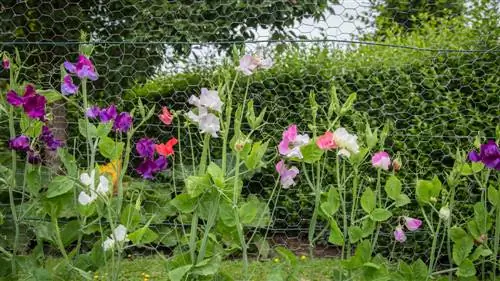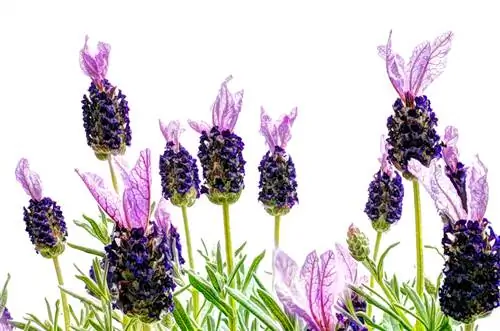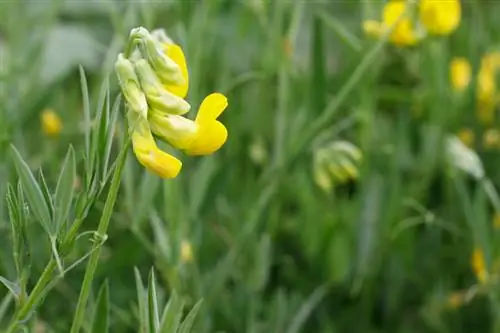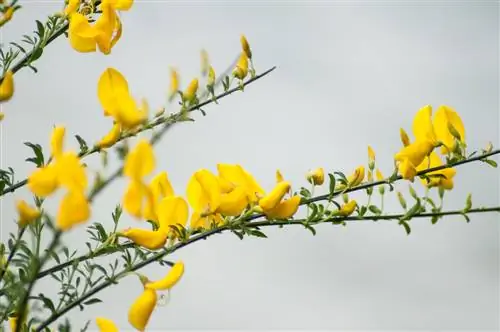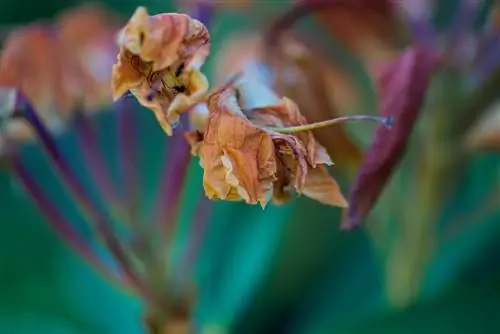- Author admin [email protected].
- Public 2023-12-16 16:46.
- Last modified 2025-01-23 11:22.
Read a commented profile about the sweet pea here with information on growth, flowering times and beautiful Lathyrus species. This is how you plant and care for sweet peas correctly.
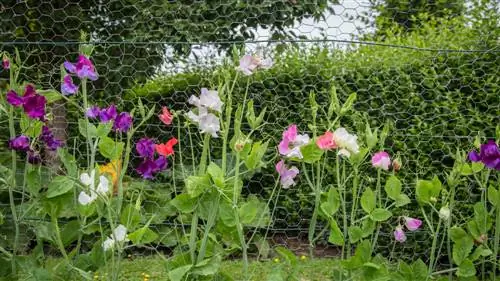
What is a sweet pea and where is it used?
The flat pea (Lathyrus) is a herbaceous plant that occurs in Central Europe and belongs to the legume family. It has pinnate leaves, racemose butterfly flowers and produces poisonous legumes. Flat peas are popular as ornamental plants in cottage gardens, natural gardens and as bee pasture.
Profile
- Scientific name: Lathyrus
- Family: Legumes (Fabaceae)
- Subfamily: Faboideae
- Genus: Flat peas with 160 species
- Occurrence: Central Europe
- Growth type: herbaceous plants
- Leaves: pinnate
- Flowers: grape-like butterfly flowers
- Fruits: pods
- Winter hardiness: hardy or sensitive to frost
- Toxicity: poisonous
- Use: cottage garden, natural garden, bee pasture
Growth
The sweet pea is an annual or perennial herbaceous plant from the subfamily of the Lepidoptera. Thanks to its picturesque inflorescences, the natural beauty is a popular ornamental plant in Central Europe. The following overview lists key growth data:
- Growth type: summer annual, short-lived plant or perennial with attractive inflorescences.
- Growth habit: prostrate, ascending or climbing, rarely upright, bushy and branched.
- Special feature: winged stems in some species.
- Growth heights: depending on the species 20 to 40 cm, 50 cm to 150 cm, 150 cm to 200 cm.
- Roots: Rhizomes with or without runners.
As typical butterflies, flat peas are valuable bee pastures, as the following video proves:
Video: Flowering perennial vetch invites fat bumblebees to harvest nectar
Species
Among 160 species within the flat pea genus, these 6 species have stood out as decorative ornamental plants for natural garden design:
| Pea species | Broad-leaved sweet pea | Spring flat pea | Fragrant sweet pea | Forest pea | Tumeric flat pea |
|---|---|---|---|---|---|
| Botanical name | Lathyrus latifolius | Lathyrus vernus | Lathyrus odoratus | Lathyrus sylvestris | Lathyrus tuberosus |
| Synonym | Perennial vetch | Spring vetch | sweet pea | Wild flat peas | Peanut-peas |
| Cultivation | perennial | perennial | annual | perennial | perennial |
| Flowering time | June to September | April to May | June to September | June to August | June to August |
| Growth | tending, climbing | upright, bushy-branched | tending, climbing | tending, climbing | upright |
| Growth height | 150 cm to 200 cm | 20 cm to 40 cm | 50 cm to 150 cm | 100 cm to 200 cm | 40 cm to 100 cm |
Other species found in Central Europe lack ornamental value suitable for the garden. These include: mountain pea (Lathyrus linifolius), swamp pea (Lathyrus palustris), meadow pea (Lathyrus pratensis) or beach pea (Lathyrus japonicus). Hobby gardeners with a penchant for rarities appreciate the blackening flat pea (Lathyrus niger) and the annual Moroccan flat pea (Lathyrus tingitanus) with wild, romantic inflorescences.
Flowers
The most beautiful decoration of a sweet pea is its colorful flowers with the characteristic features of a butterfly family:
- Flower shape: stalked, racemose or paniculate inflorescences with up to 30 individual flowers.
- Single flower: 5-fold (1 upper petal 'flag', 2 lower petals 'boat', 2 lateral petals 'wings').
- Arrangement: lateral, mostly stiffly upright.
- Flowering time: April to May or June to September.
- Flower ecology: hermaphrodite, nectar-bearing butterfly flowers.
Peas bloom white, red, pink, violet to dark red or two-tone.
leaves
You can recognize a sweet pea even when it is not in bloom by its characteristic leaves:
- Leaf shape: petiolate, pinnate, elongated-lanceolate, rounded or briefly tipped.
- Leaf color: fresh green to gray-green.
- Arrangement: opposite or alternating.
Herbaceous stipules at the base of the leaf are typical for the foliage of a sweet pea.
Excursus
Pea pods are poisonous
Fertilized sweet pea flowers turn into 3 cm to 11 cm long, flattened legumes. The spherical seeds inside are poisonous. Intentional or unintentional consumption in large quantities can trigger lathyrism, a chronic nervous disease. Serious poisoning of humans and animals is usually only to be feared if peas are used as food or animal feed.
Planting sweet peas
There are three practical options to choose from when planting sweet peas. Sowing seeds is inexpensive, either on the windowsill or directly in the bed. Hobby gardeners who are short on time decide to purchase and plant pre-grown Lathyrus plants. The decorative butterflies also demonstrate flexibility in terms of their location preferences. The best planting tips to read:
Location, soil and substrate
This is the right location for sweet peas in the garden and on the balcony:
- Sun to partial shade.
- Top location: full sun, warm and protected from the wind.
- Exceptions: Spring vetch and wild pea preferably partially shaded and cool.
- Normal garden soil.
- Top location: nutrient-rich, fresh and moist, calcareous, loose and permeable and humus.
- Bucket substrate: Mix of potting soil without peat, compost, coconut soil, sand and algae lime.
Sowing preparation
Simple preparation activates the germination of flat pea seeds. Soak the seeds in lukewarm water or chamomile tea for half a day. This is best done in a thermos flask. Hobby gardeners with sensitivity lightly scratch the 4 mm to 7 mm seeds beforehand. It is mandatory to wear protective gloves whenever you come into contact with the poisonous seeds.
Direct sowing
The best time for sowing directly into the garden bed is mid-April/end of April, in cold winter regions mid-May. How to Sow Annual and Perennial Lathyrus Seeds:
- Work nutrient-rich bed soil until finely crumbly.
- Make a furrow 4 cm to 5 cm deep (make several furrows 30 cm apart).
- Place seeds 5 cm to 10 cm apart in the furrow.
- Close the seed furrow over the dark germinators, press down the soil and water with a fine spray.
- Important: Protect seedbed from snails.
Growing on the windowsill
Swelling pots made of coconut fiber are particularly suitable for sowing under glass because you can plant the young plants together with the growing pot in the bed or bucket. It starts from mid/end of February. How to do it right:
- Place the swelling pots in a bowl, pour water over them and wait a few minutes for the swelling process.
- Press soaked seeds 2 cm deep into the middle well.
- Keep constantly slightly moist on a bright, warm windowsill.
- Pick the seedlings after 6 to 8 weeks to create bushy branches.
Plants
Read practical planting tips for purchased or hand-grown flat peas below:
- Planting pit: double the volume of the root ball.
- Starting fertilization: a handful of horn shavings per planting pit.
- Planting distance in the bed: 35 cm (spring sweet pea) to 100 cm (vetch).
- Bucket and box: create a 5-10 cm high drainage on the bottom of the container made of pottery shards, grit or expanded clay.
Various climbing aids are suitable for climbing types of sweet peas. These include pergola, trellis, fence, trellis or bamboo poles.
Caring for the common pea
The sweet pea is easy to care for. Regular gardening attention is rewarded with bushy branching, fabulous abundance of flowers and an extra long flowering period. The following care tips summarize all the important aspects:
Pouring
- Water the pea in dry conditions, up to twice a day in summer.
- Use normal tap water as irrigation water.
- Run water directly onto the root disc to prevent mildew.
Fertilize
- Annual flat pea: no fertilization required.
- Perennial flat pea in the bed: fertilize every spring with compost or horn shavings.
- Perennial flat peas in a bucket/box: add liquid flower fertilizer to the irrigation water from April to August.
- In July, pile up 10 cm to 20 cm high with compost soil.
Cutting
- Clean out wilted flowers every few days.
- After the first bloom, cut back by a third or half to continue the flowering period.
- Cut back excessively long stems that protrude from the climbing aid.
- Extra tip: do not clean or cut some of the annual flat peas so that the legumes ripen for self-sowing.
Perennial vetch, sweet pea and other perennial lathyrus receive a radical pruning in autumn or late winter. If necessary, detach the stems from the climbing aid and cut the perennials at ground level.
Wintering
Perennial flat peas overwinter in beds without any special protective measures. In the bucket, perennial vetch, spring vetch and other species are vulnerable to frost. After the autumn pruning, place the planter on an insulating wooden block. Cover the pot with jute, winter fleece or bubble wrap. A mulch layer of leaves and needle twigs on the root disc protects the perennials from moisture and cold. It is recommended to change location to the wall of the house that is protected from the wind.
Propagate
Propagate a sweet pea is easy. Harvest the ripe legumes in autumn. Before removing the poisonous seeds from the pods, please put on gloves. Store the dried seeds in a cool and dry place until the window for sowing opens next year.
If you are afraid of handling toxic Lathyrus seeds, you can propagate the perennials by dividing them. The best time is in spring. Lift the root ball out of the ground. Using a spade or sharp knife, cut the peas into several segments. Plant the sections in nutrient-rich soil at the new location and water.
Popular varieties
A colorful dance of beautiful Lathyrus varieties enchants beds and balconies with colorful flowers in harmony with nature:
- White Pearl: white-flowering perennial vetch (Lathyrus latifolius), ideal as a decorative fence greenery, climbs up to 2 m high.
- Pink Pearl: pink flowering broad-leaved sweet pea, beautiful in the perennial garden and as a cut flower, growth height up to 2 m.
- Alboroseus: distinctive spring flat pea with violet-purple flowers, picturesque ornamental plant with a height of 20-40 cm.
- Grandiflora Cupani: historical, annual sweet pea variety with dark red, purple-pink winged flowers.
- Balcony sweet pea 'Laura': Premium variety for the sunny balcony with a height of 50 cm and a width of 20 cm.
FAQ
Are the pods of a sweet pea edible?
The legumes of numerous types of flat peas contain poisonous seeds. For this reason, the pods are not suitable for consumption. In the worst case, the toxins contained therein, such as lathyrogenic amino acids or butyric acid, can cause a chronic, neurological disease. If the legumes are used as animal feed, cows, horses and other affected animals suffer from agonizing symptoms of poisoning.
Is the broadleaf pea winter hardy?
The broad-leaved sweet pea (Lathyrus latifolius) is rightly called perennial vetch because the herbaceous plant is perennial and winter-hardy. No special precautions need to be taken in the bed for winter protection. The flat pea is only vulnerable to frost as a container plant. A winter coat on fleece and a wooden block as an insulating base guarantee successful wintering.
Do you have to cut a sweet pea?
Basically, you can just let a sweet pea grow. To ensure that the herbaceous plant has dense, bushy branches and lush flowers, occasional pruning is beneficial. Prune seedlings before the stems grow upwards. Clean out wilted flowers regularly or cut back all shoots by half after the first bloom. Cut perennial flat peas at ground level in late winter.

